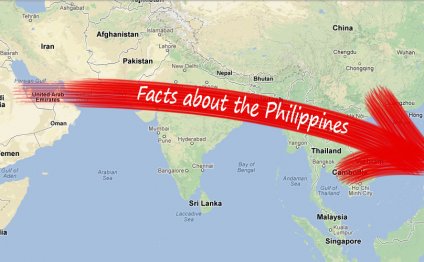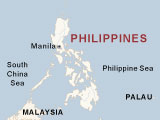
About the Philippines

Fast Facts
Population: 84, 765, 000 Capital: Manila; 10, 677, 000 Area: 300, 000 square kilometers (115, 831 square miles) Language: Filipino (based on Tagalog), English, and 8 major dialects Religion: Roman Catholic, Protestant, Muslim, Buddhist Currency: Philippine peso Life Expectancy: 70 GDP per Capita: U.S. $4, 600 Literacy Percent: 96
Map
The Philippines, in southeastern Asia, consists of 7, 107 islands lying between the South China Sea and the Pacific Ocean. The islands of Luzon and Mindanao account for two-thirds of the land area. Even though the Philippines lies just north of the world's largest Muslim state, Indonesia, it is about 94 percent Christian—mostly Roman Catholic. About five percent of Filipinos are Muslim, mostly living on the islands of Mindanao and Palawan—islands closest to the Muslim countries of Malaysia and Indonesia.
In 1521 Ferdinand Magellan claimed the Philippines for Spain, which ceded the islands to the U.S. in 1898. Independence came in 1946, after Japanese occupation ended. Widespread poverty and political corruption sparked social unrest starting in the 1970s. In 1986 President Ferdinand Marcos was compelled to hold an election. Despite his fraudulent claim to victory, Marcos was forced into exile, and Corazon Aquino, widow of a murdered opposition leader, became president. The government continues to make progress in negotiations with Muslim rebels with a cease-fire in 2003, and it works to provide political representation and economic development to the Autonomous Region of Muslim Mindanao.
ECONOMY
- Industry: Textiles, pharmaceuticals, chemicals, wood products
- Agriculture: Rice, coconuts, corn, sugarcane; pork; fish
- Exports: Electronic equipment, machinery and transport equipment, garments, coconut products
RELATED VIDEO



Share this Post
Related posts
Info About the Philippines
The Philippines 7, 107 islands stretch 1, 839 kilometers from the northernmost tip of Batanes to the southernmost island…
Read MoreBest Resort In The Philippines
After an exhausting work week or a personal accomplishment, there’s no better way to reward yourself than a beautiful tropical…
Read More










